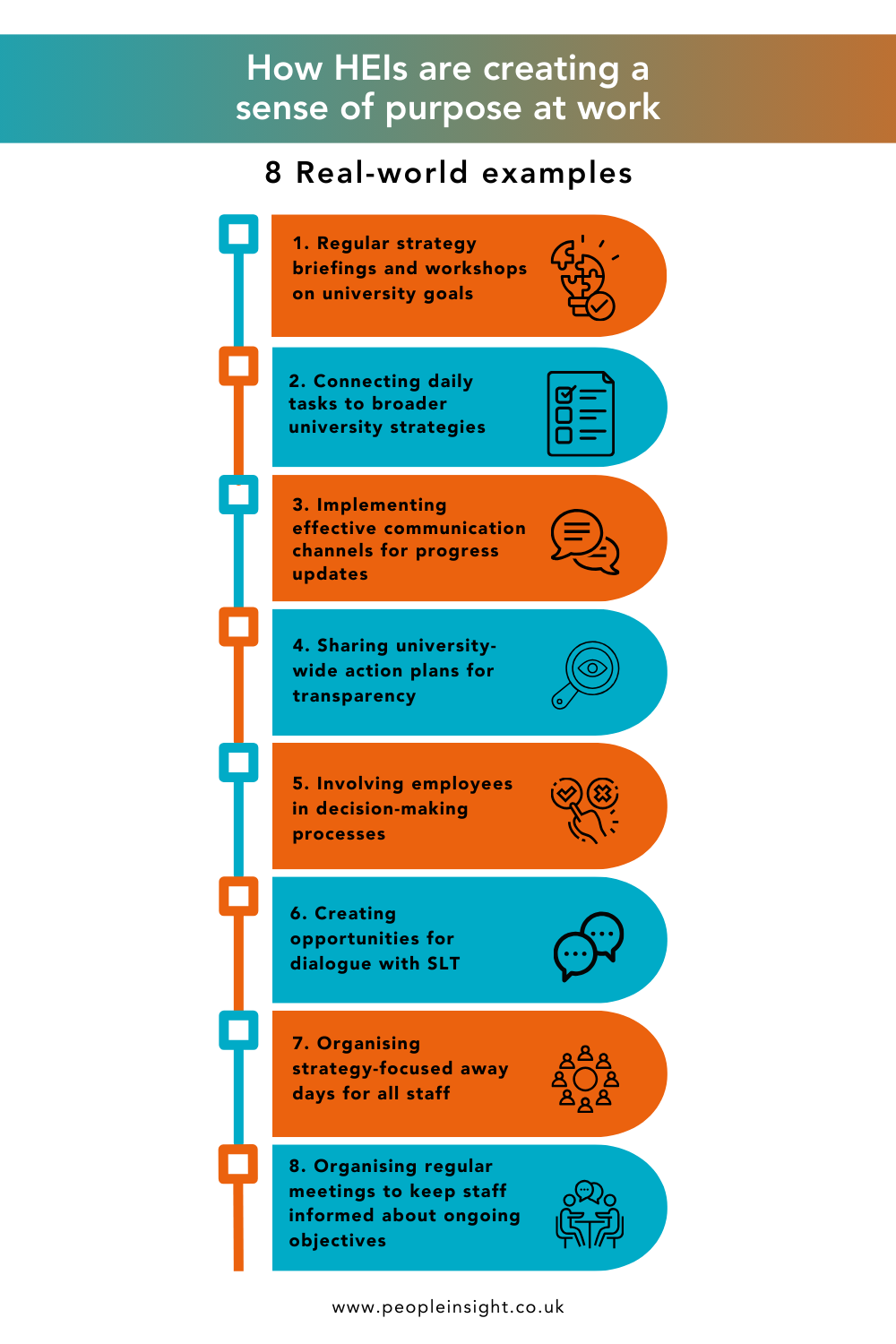
No matter the sector, creating a sense of purpose at work is important. After all, a sense of purpose can make or break employee engagement. When organisations are able to provide employees with a purpose at work that aligns with them and their values, you can inspire great performance while retaining them for years. Purpose can directly influence how motivated and connected staff feel to their institution’s goals.
When it comes to Higher Education Institutions (HEIs), the concept of purpose is all the more important. Employees are often drawn to the sector and to their roles by a desire to contribute to society and make a meaningful impact. Without a clear sense of purpose, employees may struggle to understand how their work contributes to the institution’s broader mission, which can cause frustration and, ultimately, disengagement. To keep these passionate and dedicated employees working and feeling at their best, it’s important to keep purpose in mind at all times.
Here at People Insight, we’re proud to have worked with over 75 HEIs, from Russell Group universities to post-1992 institutions and music conservatories. We help them create, optimise and deliver employee listening strategies while boosting engagement. Thanks to all our work with these amazing HEIs, we have some great, real-world examples of how HEIs have created a sense of purpose for employees at work. Putting these strategies into effect has had some profound and meaningful impacts on engagement, morale and retention.
Read further: 75% of employees at UAL report work providing a sense of personal achievement

After realising that their staff wasn’t entirely aligned with the mission and purpose of the institution, or knowledgeable about how it was doing against their goals, one university decided to take action. They decided to implement regular strategy briefings by senior leaders, alongside university-wide newsletters and annual ‘State of the University’ events. This provided staff with a clearer understanding of the institution’s overall direction. The university also organised strategy-focused away days and workshops on strategic goals.
All of this helped bridge the communication gap, which is common in many HEIs. According to recent data, only 35% of HE employees fully understand how their institution is performing against its objectives, which is a stark contrast to the broader cross-sector benchmark of 62%. By making institutional goals and progress more transparent, this university is helping employees feel more aligned with its mission, hugely boosting their sense of purpose.
Another university made strides in linking daily work with the institution’s strategic direction by introducing regular team meetings. These meetings specifically focused on how everyday tasks contribute to broader university goals. Employees were encouraged to reflect on the impact of their work within the larger institutional framework.
This tactic is highly effective in giving staff a tangible sense of purpose. By understanding how their individual efforts support the university’s overall strategy, employees are more likely to feel that their work has meaning and that they are contributing to a greater cause. This connection between daily tasks and long-term objectives can lead to higher engagement and job satisfaction.
Related: Data reveals why people love working in higher education
A third university took a systematic approach to communication, ensuring that progress updates were shared through the most effective channels. After evaluating existing methods, the institution found that some key communication channels were missing. New systems were developed to keep staff better informed, including digital platforms for regular updates and forums for staff to engage in discussions.
This move underscores the importance of clear and timely communication in providing and nurturing a sense of purpose. With only 35% of HEI employees reporting that they understand their institution’s progress, this university’s focus on communication addresses a common issue. Using the right channels for communication allows staff to see the impact of their work in real time, making them feel valued and more connected to institutional goals.
One HEI enhanced transparency by sharing university-wide action plans with all staff members. This level of openness around future plans and ongoing projects allowed employees to see exactly how their work fits into the institution’s roadmap. This transparency really paid off, ultimately reducing anxiety and uncertainty relating to their roles, while increasing their enthusiasm for their daily work.
When it comes to creating a sense of purpose, you really can’t overestimate the importance of transparency. Employees are much more likely to feel motivated when they are aware of what’s happening around them at all levels of the organisation. This approach helps employees to connect their day-to-day efforts with the bigger picture — what better way to show staff the value of their work?
At another university, employees were given opportunities to participate directly in decision-making processes, particularly when it came to institutional changes. This approach created a sense of ownership and accountability among staff, as they felt their input was valued and their perspectives were taken into account.
By involving staff in key decisions, this university is creating an environment of trust and collaboration. When employees are actively engaged in shaping the direction of their institution, they are more likely to feel a deep connection to its success. This sense of purpose arises when individuals know that their voices matter and that their contributions can influence the institution’s growth. Involvement in decision-making also boosts morale and creates a culture of shared responsibility where employees see themselves as integral to the institution’s success.
Related: Change management in higher education: Why is it so hard?
One university client of ours recognised the importance of open communication between staff and leadership and created regular opportunities for dialogue between employees and the SLT. These meetings allowed staff to discuss their concerns, provide feedback and ask questions about the university’s progress and future plans.
This initiative helped to break down barriers while allowing staff to feel heard and valued by their leaders. Regular interactions with senior leadership provide employees with a clearer understanding of the institution’s direction, while also giving them a platform to express how their work aligns with these goals. This two-way communication works to create a sense of belonging, making employees feel they are not just passive observers but active participants in their HEIs journey.
Related: How King’s College London achieved a 75% employee engagement score
Another university strengthened its efforts to engage staff by organising away days dedicated to discussing university strategies. These events gave employees the opportunity to step away from their daily routines and focus on understanding how their roles contribute to the institution’s broader mission. Senior leaders used these sessions to provide updates on the university’s performance and future objectives.
Away days like these are a fun, refreshing and effective way to instil a sense of purpose at work. By giving staff time to reflect on the institution’s goals and their own role in achieving them, these events help employees to see the bigger picture. This helps staff feel more connected to the institution’s mission, reinforcing their sense of purpose as they return to their daily roles with renewed clarity and motivation.
Our final example comes from a university that organised regular meetings to keep staff informed about the university’s ongoing actions and objectives. By consistently sharing updates on key projects and progress, the institution created an environment where staff were well-informed about where the university was heading and how their work played a role in getting there.
This approach helps to close the communication gap that exists in many HEIs, where staff may feel disconnected from leadership or unaware of progress toward strategic goals. When employees understand the institution’s priorities and how their work aligns with these, they are far more likely to feel a sense of purpose.
Real-world examples from universities show how various actions, from regular strategy briefings to team meetings and opportunities for dialogue with leadership, can create a stronger sense of purpose at work. When employees see how their individual roles contribute to the institution’s mission, they are more likely to take pride in their work, feel connected to the institution and remain committed to its success. These strategies not only benefit employees but also have a noticeable impact on the institution’s performance, leading to better outcomes for both staff and students alike.
If you’re looking to improve levels of employee engagement at your HEI, get in touch to find out how a higher education staff survey can help. We work with over 70 universities within the UK and we can implement an employee listening strategy that drives real results.
Read more in our HE Actions series:
12 Ways unis are improving wellbeing in higher education
10 ways HEIs are proactively addressing reward and recognition
5 ways HEIs are actively improving their physical work environment
How HEIs are improving communication at work
How universities are tackling equal treatment for staff
7 Steps universities are taking to improve training & development
